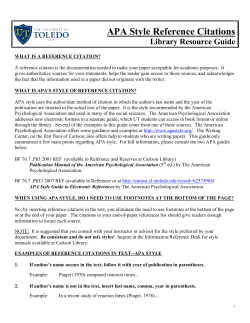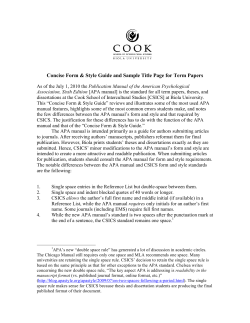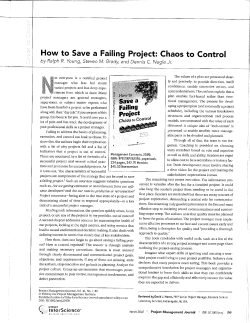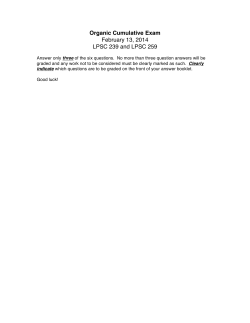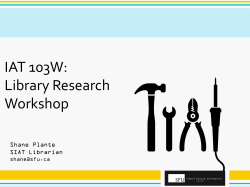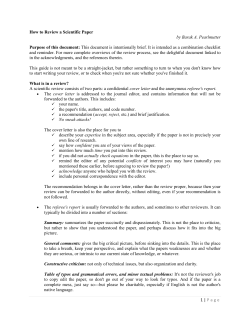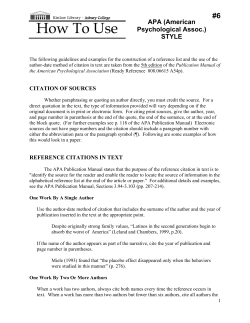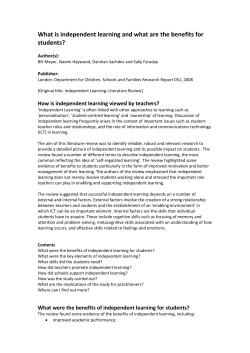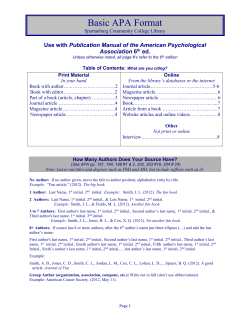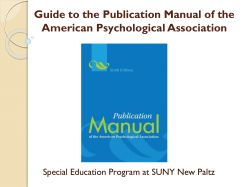
APA Style: Sample Bibliographic Entries (6 edition) Reference Services
Maxwell Library Bridgewater State University APA Style: Sample Bibliographic Entries (6th edition) Reference Services The Clement C. Maxwell Library BRIDGEWATER STATE COLLEGE The American Psychological Association (APA) documentation format uses in-text citations that briefly identify the source, enabling the reader to locate full bibliographic information on each source in the list of “References” at the end of the essay, article, or book. Numbers in brackets and page numbers refer to sections or pages of the Publication manual of the American Psychological Association (6th edition), available at the Circulation Desk. This latest manual is easier to use. Chapter Six includes: Citing References in Text (beginning 6.11) and Publication Information (beginning 6.30). An important change in this latest edition is the inclusion of DOI numbers on citations (when they are available). Chapter Seven includes a number of examples. APA In-Text Citations The APA style uses the author-date method of citation. For direct quotations in print sources, a page number is given within the parenthesis. If the source used is electronic and does not have page numbers, use the paragraph number. [6.05] Type of Entry Example One Work by One Author [6.11] A modern scientist has a particular relationship with his own dignity that is far from ideal (Lacan, 2008). One Work by Multiple Authors (6.12) If the authors’ names are mentioned in a signal phrase, only the date is included in parenthesis Pellegrini and Bjorklund (1998) believe the study of children more complex than previously recognized. One Work by Six or More Authors (6.12) When there are six or more authors, cite only the surname of the first author followed by et al. and the year. Note: since this example is a direct quote, the page number is also included in the parenthesis. [6.03] “There are particular gaps and inconsistencies in the study of relations between martial conflict, ANS responding, and children’s externalizing problems” (El-Sheikh et al., 2009, p. 2). Groups as Authors If the author is a government agency or other corporate organization with a long name, spell out the name the first time it is used, followed by an abbreviation in brackets and the year. In subsequent references, just use the abbreviation and the year. [6.13] First Citation: (American Psychological Association [APA], 2009). Subsequent Citations: (APA, 2009). No Identified Author Cite by title of the book or article either in a signal phrase (see example) or in the parenthetical citations and include year of publication. [6.15] According to Joint investigations of child abuse (1993), effective intervention requires trained personnel. Electronic Source without page numbers. To cite a specific part of a source, or when quoting directly, if page numbers are not provided, use paragraph number, preceded by paragraph abbreviation. If neither are visible, cite the heading and number of paragraph following. [6.05] “Researchers have not yet adequately examined the degree to which parents’ self-feelings may play a moderating role in the network of relationships …” (Kaplan, Xiaoru, & Kaplan, 2001, Theoretical framework, para. 2) 1 Maxwell Library Bridgewater State University Personal Communication. Includes private letters, personal interviews, telephone conversations. Not included in References list. [6.20] Day care providers in New Bedford, Massachusetts face increasing difficulty in finding quality staff (N.D. Cruz, personal communication, November 16, 2009). APA “References” List The APA format calls the list of books, periodicals, print and non-print materials “References.” Some Guidelines for preparing the “References” list: • • • • • • • • • • • • Use a separate page and type References, centered, at the top. Double-space all entries. For second and subsequent lines, use the Hanging Indent style. Include only sources that document your article and “provide recoverable data.” (page 180] Alphabetize by author’s (or editor’s) last name, or by the first significant word in the title if there is no author or editor. [6.25] Invert all authors’ (or editors’) names, using surnames and initials only for up to and including seven authors. For eight or more authors, include the first six, insert three ellipses, then add the last author’s name. [6.27] Use the ampersand (&) rather than “and” in the author (or editor) entry. [6.27] The date of publication (in parenthesis) follows the author’s (or editor’s) name or title if there is no author (or editor). [6.28] Titles of books and names of periodicals are in italics. The first word of the title or subtitle of a book (if any) and any proper nouns are capitalized. Use upper and lower case letters for periodicals [6.29] After the title of the journal or magazine, give the volume number in italics. [6.30] For electronic version based on a print source (PDF format), provide inclusive page number for the article. For references from newspapers, use pp. before the page numbers. [6.32] Additional information for book, such as editions or volumes, is in parenthesis immediately after the title of the book. [6.29] Provide the DOI if one has been assigned. When there is a DOI, no further retrieval information is required (no name of database, no date accessed). However, provide the URL of the journal, magazine, newspaper, or book. [6.32] APA References Examples (see Chapter Seven) Note: The following examples have been adjusted to save space. Please see the manual for proper format (page setup, line spacing, margins). Type of Entry Book, one author (or editor) (6.27;7.02) Examples for References List Harris, L. (2007). The suicide of reason: Radical Islam’s threat to the enlightenment. New York: Basic Books. Book, two authors (or editors) Note: the example also shows an edition other than the first. (7.02) Pellegrini, A. D., & Bjorklund, D. F. (1998). Applied Child Study: A developmental approach (3rd ed.). Mahwah, NJ: Erlbaum. Essay or chapter in collection or anthology. (6.27) Baker, S. L., Patterson, M. D., & Barlow, D. H. (2002). Panic disorder and agoraphobia. In A. M. Martin & D. H. Barlow (Eds.), Handbook of assessment and treatment planning for psychological disorders (pp. 67112). New York: Guilford Book with no author or editor [6.27] Joint investigations of child abuse: Report of a symposium (1993). Washington, DC: National Institute of Justice. 2 Maxwell Library Bridgewater State University ELECTRONIC SOURCES Journal article, with issue number and DOI [6.30; 6.32;7.01]. Talbot, L. S., Hairston, I. S., Eidelman, P., Gruber, J. & Harvey, A. G. (2009). The effect of mood on sleep onset latency and REM sleep in interepisode bipolar disorder. Journal of Abnormal Psychology, 118 (3), 448-458. doi: 10.1037/a0016605. Journal article, Eight or more authors and DOI [6.27; 6.32;7.01] Manwaring, J. L., Bryson, S. W., Goldschmidt, A. B., Winzelberg, A. J., Luce, K. H., Cunning, D. ... Taylor, C. B. Do adherence variables predict outcome in an online program for the prevention of eating disorders? Journal of Consulting Psychology, 76 (2), 341-346. doi: 10.1037/0022-006X.76.2.341. Magazine article, no DOI [6.27; 6.28; 6.32; 7.01] Toufexis, A. (1990, October 8). Living struggling for sanity. Time, 136, 47-48. Retrieved from http://www.time.com/time/magazine Daily newspaper article, no DOI [6.28; 6.32; 7.01] Goldberg, C. (2009, January 19). An evolving view of depression. Boston Globe, pp. A11. Retrieved from http://search.boston.com/local/Historic.do AUDIO VISUAL MEDIA Motion Picture [7.07] Berman, B. (Producer) & Eastwood, C. (Director). (2003). Mystic River. Warner Brothers. Revised 11/19/09 3
© Copyright 2025
